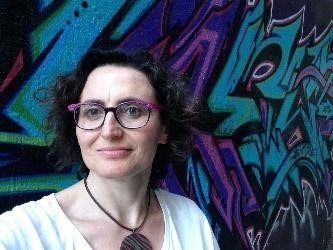Clarissa Clo is Associate Professor and Director of the Italian Studies Program in the Department of European Studies at San Diego State University.
Title
Youth and Music Subcultures in Italy
Goal
In Fall 2015 I taught ITAL 422 (Issues in Italian Studies) on the topic of "youth and music subcultures in Italy." The course made extensive use of materials held in the Italian Hip Hop Archive of the University Library's Special Collections (donated to us by folklorist Joseph Sciorra), which includes the periodical Aelle/ AL, the most prominent 1990s Italian underground hip hop magazine (1995- 2001). Students conducted research on authentic content in the target language (Italian), and organized and curated their findings in four final digital group projects. To prepare for the task and to acquire both analytical and linguistic skills, students read and collaboratively annotated sources in Italian pertaining to youth and music subcultures in cross-cultural and historical perspective (such as an academic essay about the history of youth cultures in Italy since the 1950s and a graphic novel by Claudio Calia on Centri Sociali Italiani, autonomous occupied spaces where hip hop first developed in Italy). Students then tackled the Italian Hip Hop archive's primary sources. They visited the collection in the library, consulted several magazine issues, selected articles and artists of their choice to be featured in their projects.
Lesson Plans
The final group projects tied all this research together in visual and auditory storytelling about Italian hip hop culture. Students worked in four groups to create four Story Map journals using Esri ArcGIS technology, producing geographical based narratives with accurate satellite locations, images, videos and links. Students wrote their arguments using complex linguistic concepts and enriching the narrative with multimedia materials. They applied a geospatial methodology to produce digital scholarship that also showcased Italy's regional and cultural diversity. The study of Italian language and culture in this course was contextual, dynamic, and meaningful to the learning experience of the students.
Outcome/Examples
Hip hop italiano (link: https://www.arcgis.com/apps/MapJournal/index.html?appid=36d80c623d9a4b4291eea52c9ae27 9ac) Aelle/AL magazine (link: https://www.arcgis.com/apps/MapJournal/index.html?appid=23890feef7764e09bcf80ef1261ddce f) Centri sociali (Youth Social Centers) (link: https://www.arcgis.com/apps/MapJournal/index.html?appid=818142b895714030a4619bbd9f189 9a1)
Culture giovanili (Italian Youth Cultures since 1950s) (link: https://www.arcgis.com/apps/MapJournal/index.html?appid=d43963aa3c424c13a2508e7cf4e01d 1c)
Reflection
The projects attracted the interest of digital scholars in the Humanities and one of the story maps ("Hip Hop Italiano") will be featured as a model of curated artifact in the "Interface" keyword of the Modern Language Association's online volume Digital Pedagogies in the Humanities: Concepts, Models and Experiments, whose final version can be accessed here. As a result of these projects, I was also invited to deliver a keynote address at the Southwestern Association for Language Learning and Technology (SWALLT) symposium was organized by Dr. Trevor Shanklin at LARC on April 1st and 2nd, 2016. My presentation was entitled "Inventing the New Renaissance Generation: The Digital Humanities in the Foreign Language Classroom through Visual Storytelling, Student Curation and Geospatial Scholarship." I discussed and showcased some of the digital projects my students and I have developed in various courses, including the latest digital humanities projects on Italian hip hop and youth cultures produced in ITAL422. For this portion of the presentation I had invited two students, Alberto Ceresoli and Sophia Zarzosa, to join me on stage to share their research and illustrate how their final projects for the course on Italian music and youth subcultures, which they had organized in ArcGIS story maps. Students discussed their work and the significance that the topics studied played in their own acquisition and knowledge of Italian language and culture. Inviting the students in this occasion was important for me in order to provide them with a public platform in which to gain professional experience, and also to exemplify to them and the audience in attendance the power and potential of undergraduate research in fostering a scholarly culture in which students are not just passive recipients of knowledge but also active producers of it. Both students found the experience important and invigorating and the audience was captivated by their expertise and exposition. The recording of the presentation and the slide show I used can be accessed here. The process of the course development, including research in the library's Special Collections, from documentation to digital implementation, is here. These projects, developed in conjunction with the NEH-sponsored Digital Humanities Pedagogies workshop organized by Jessica Pressman and Joanna Brooks, benefited from the discussion and collaborations with other colleagues involved in the group, both at SDSU and in the greater San Diego region, especially in terms of teaching practices and assignment design.
